Five years after GW launched its first free massive open online course, faculty continue to tout its advantages for students.
Officials currently offer four MOOCs, which allow anyone to enroll at any time for a self-paced class in engineering or nursing after cutting two classes in summer 2018. Officials said the courses help their schools reach out to thousands of people from around the globe and make learning accessible beyond the GW community for students who can not attend classes full- or part-time on campus or online.
Ken Schappelle, the director of marketing and communications for the School of Nursing, said the school’s MOOC offerings have helped nursing faculty disseminate their knowledge through an accessible medium at no cost.
“By the belief that all people deserve quality health care, we aspire to be trusted advocates for the advancement of societal well-being in the clinic, community and statehouse,” he said in an email. “Sharing the MOOC with the world is one way for GW Nursing to be an advocate of these values.”
UPCEA, along with ACE, and other organizations, wrote to Committee on Education and Labor Chairman Bobby Scott and Ranking Member Virginia Foxx to offer views on H.R. 4674, the College Affordability Act (CAA) introduced by Chairman Scott that will be marked up by the Committee. Any comprehensive Higher Education Act (HEA) reauthorization proposal represents a substantial commitment on the part of the Committee, and we are appreciative of the effort reflected in this bill. Our comments reflect the version of the bill as it was introduced. The bill incorporates a number of proposals that institutions of higher education have historically supported and believe would be beneficial. In particular, the bill provides significant increases in student aid and institutional support, especially for institutions that have been historically under resourced. However, the bill also includes a number of provisions that would be highly problematic if enacted, as well as several major proposals where the likely outcomes are unknown due to a lack of reliable data for analysis or due to a lack of specificity in the legislative text.
Crime in the United States is projected to decline. Hollywood gives us many dramatic scenarios of what the future could be, although over the next few decades, it is unlikely to be that depicted in the Sylvester Stallone movie Judge Dredd, where crimes are judged and punished on the spot. However, with the adoption of greater technologies and the use of predictive analytics, the scenario illustrated in Tom Cruise’s Minority Report is more likely, although crime will be predicted in advance by supercomputers rather than by mythical beings called “pre-cogs.” This is more realistic given the power of computing at hand coupled with vast amounts of data being collected.
While the public perception is that crime rates have not improved or have gotten worse[i], they have actually been on the decline in the United States for quite some time. The reasons include a variety of factors and possibilities. Some attribute the rise or decline of crime to crackdowns or influences of illegal drugs, the economy, alcohol usage or even gun control. Another possibility would be the decriminalization of certain crimes, such as the use of marijuana in some states.
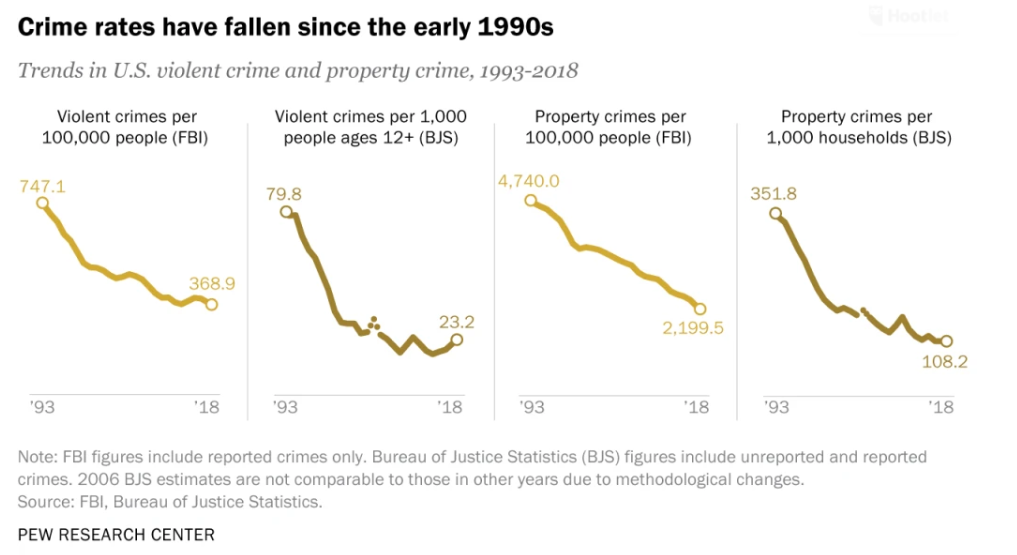
However, one argument as a deterrent to crime is advances in technology such as the use of cell phones to report or record a crime. New technologies including the use of surveillance cameras, analytics and predictive methods, DNA testing and smart building technologies are having an impact. As a result, it is expected that new technologies will improve enforcement and prevention which most likely will result in greater efficiencies and labor changes which are forecasted to increase over the next decade. Table 1 shows a predicted 6% increase in detectives and criminal investigators, police and sheriff’s patrol officers and other professions. However, forecasts show that given the demographics of the country coupled with decreased immigration, the United States is expected to see historically low population growth over the next decade[ii].
Table 1 – Occupational Statistics (Emsi 2019)
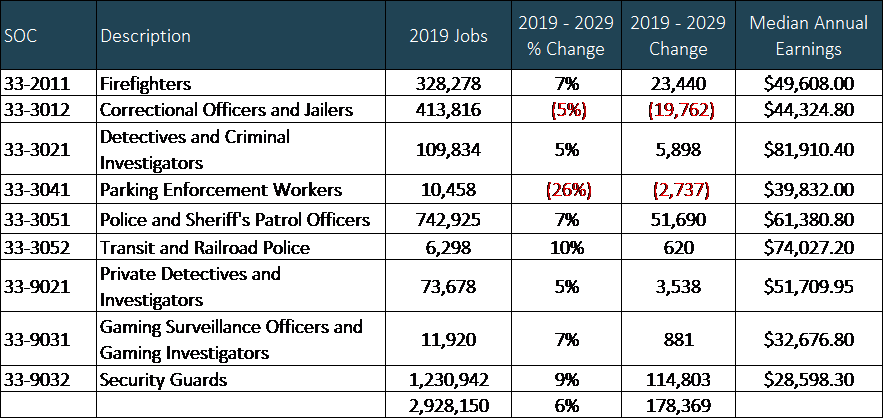
Using Emsi data, the table below shows an analysis of job postings as they relate to the “law enforcement” category. The table shows the posting intensity to be high for those in the analyst community. This coupled with a high median posting duration suggests higher demand or an inability to fill open positions.
Table 2 – Job Analytics for Law Enforcement Workers (SOC 33-3000)
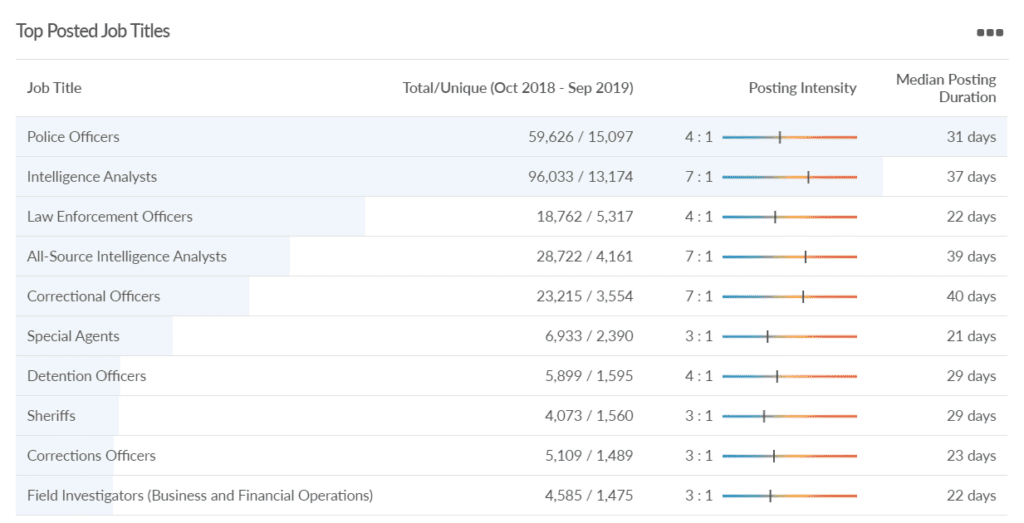
Source: Emsi
With law enforcement jobs and the landscape of crime changing, it is also likely that the criminal justice degree is in need of an overhaul. Many degree programs have classic courses in juvenile delinquency, drug abuse, the corrections system and the court and justice systems. Some even have courses specific to gender or race. However, few curricula that the UPCEA Center for Research and Strategy reviewed had topics related to new technologies or current issues.
Figure 1 – Snapshot of One Institution’s Curriculum
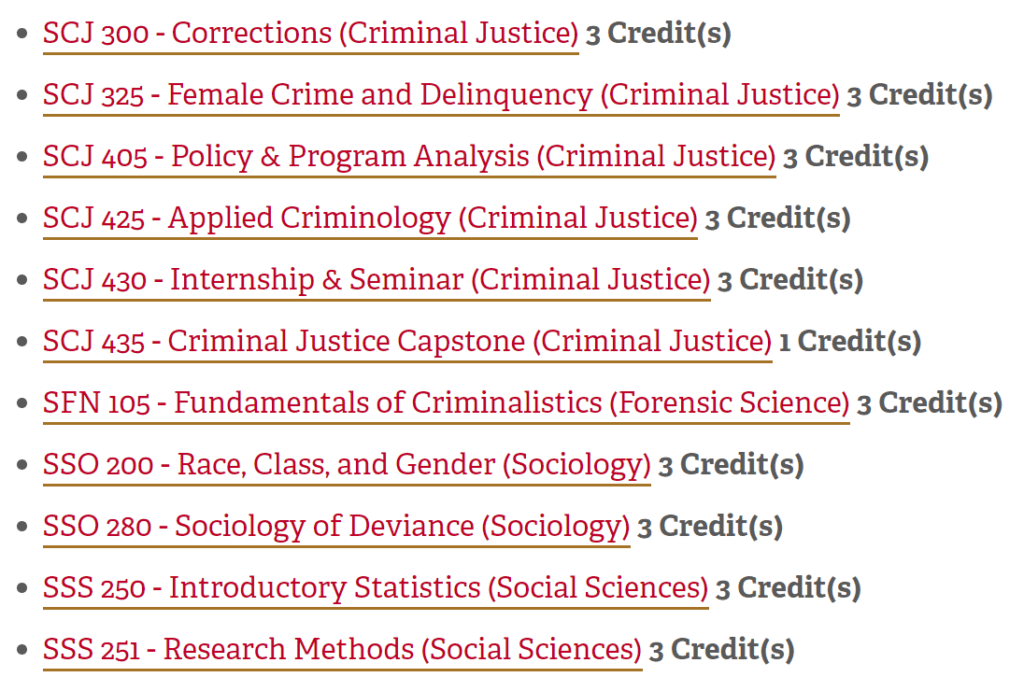
With the advancement of new technologies, is the attractiveness of a degree in criminal justice or criminal studies less? Do institutions need to consider a revision to curricula to address the use and deploying of new technologies, cybercrime, crimes of today, identity theft, conflict between law enforcement and society, new approaches to race relations, new approaches to community policing, the impact of DNA or forensics, or the use of analytics to prevent crime?
With the approach of a new economy fueled by automation and improved communication, it is likely that crime in monitored places will decrease. Quantum-computing accessing enormous data sets coupled with a video-driven society will likely prevent, predict or identify crime. A traditional response to a crime has been a show of human force. A future response could take the form of drones and other mechanized devices. New training will also be needed, as will new curriculum. Law enforcement, like the military, often uses simulations and other preparatory exercises. The use of virtual or augmented reality technologies could also improve law enforcement approaches in a new economy. New weapons, lethal and non-lethal, are certain to enter the law enforcement community. Improvements to facial recognition and other identifying technologies will also improve to the point of adoption.
With all of these developments impacting law enforcement, policies and laws will change. How law enforcement personnel and technologies are managed, used, and deployed will also be subject to change. The courts and legal system will change, thus opening up new avenues of training and education.
Higher education will need to re-evaluate its existing curriculum for relevancy. Institutions will also have an opportunity to provide new training to those with existing criminal justice credentials. They will also have opportunities to deploy new certificates or badges in evolving content areas. To sit back and do nothing and continue using dated curriculum while promising graduates jobs and good salaries in a new economy would be a crime in itself.
[i] Pew Research Center and Gallup research
[ii] Brookings Institute
| Welcome to the October edition of Policy Matters. Each issue has the latest updates and actionable items in public policy for adult and nontraditional education stakeholders. |
Major Update
|
Other Reads
We’d like your input! Like this format? Submit comments, or ideas for topics of inclusion in this newsletter. For more information on UPCEA government affairs, contact Jordan DiMaggio ([email protected]). Follow Policy Matters for conversation about ongoing public policy efforts, to stay abreast of major news stories, and to contribute your insights on the policy space. All UPCEA members are automatically subscribed to Policy Matters. We hope this newsletter makes you better informed on public policies that may impact your institution, students, and the broader higher education community. |
I recall the advent of the ILLIAC computer, ARPANET (that grew into the internet), the personal computer, the mobile phone, the smartphone, and other advancements in technology that have had such a huge impact on our society. Yet these are mere drops in the ocean compared to the impact we will see from the advent of quantum computing. Earlier this year, Google’s 53-qubit computer reached computing supremacy, and from now on the world will never be the same. In a huge step forward in computing, a Google research paper published on the NASA website, detailed the moment:
Google’s quantum computer was reportedly able to solve a calculation — proving the randomness of numbers produced by a random number generator — in 3 minutes and 20 seconds that would take the world’s fastest traditional supercomputer, Summit, around 10,000 years. This effectively means that the calculation cannot be performed by a traditional computer, making Google the first to demonstrate quantum supremacy.
That’s astounding — 200 seconds compared to 10,000 years. IBM has a similar-sized quantum computer, and Google claims to have yet another much more powerful 72-qubit computer. The IBM Summit computer at Oak Ridge Labs is no slacker; it boasts specs of “a peak performance of 200 petaflops, or 200,000 trillion calculations per second. Summit more than doubles the top speeds of TaihuLight, which can reach 93 petaflops. Summit is also capable of over three billion billion mixed precision calculations per second, or 3.3 exaops, and more than 10 petabytes of memory, which has allowed researchers to run the world’s first exascale scientific calculation.”
The supremacy challenge earlier this summer was based on a problem given to both the Summit and the Google Quantum computers to prove that a set of numbers was truly random. That’s a rather esoteric test, but it demonstrates the magnitude of superiority of quantum computing: 200 seconds compared to 10,000 years.
Do you recall Moore’s law? That’s the axiom developed by Gordon Moore some two dozen years ago that the processing power of computers would double every 18 months to two years. Now, quantum computing has ushered in Hartmut Neven’s law. His law predicting growth in quantum computing power is one that is doubly exponential. That is two to an exponent of two to a second increasing exponent. Charted on a graph, that growth rate appears to become nearly vertical.
What does this mean for our society and world? It means that we now have a tool to process enormous sets of data and find patterns such as cause-effect relationships that we have never been able to discover previously. That, in turn means we may be able to generate truly accurate weather forecasting, more accurately predict all kinds of actions in society, discover causes and cures for diseases, and much, much more. In short, we can squeeze solutions out of the big data that we are now and have been gathering in recent years.
What does that mean for higher education? Over the next decade, as we begin to harness the power of this new tool, it will mean many things. Through processing the huge amount of data we are collecting on students, we may be able to develop truly personalized learning that will power a new era in individual learning, knowledge and achievement. We will be able to identify prospective student matches with our institutions and programs with a quality that we have never been able to achieve before. We will be able to predict job market growth and demand for skilled and knowledgeable workers with precision. And, with growth at the rate of Neven’s law, there will be so much more every month that passes.
When will this happen? It is beginning today. The year 2020 will see significant advances, including expanded access to quantum computing power in milliseconds on the cloud. Quantum computers for the foreseeable future will do the heavy lifting of processing, but then they will turn the job over to our more pedestrian computers to refine, synthesize and implement. The 2020s will be decade of quantum computing.
This article originally was published in Inside Higher Ed’s Inside Digital Learning blog.
By SmartBrief Editors
This post is produced in partnership with UPCEA.
The world of professional, continuing and online education is in constant flux. Former associate dean of academic affairs at Syracuse University and current University of North Carolina at Greensboro division of online learning dean, Dr. Karen Bull provides her perspective in this online learning Q&A.
Question: Tell us about your journey into and in the professional, continuing and online education field.
Answer: As a young child, I saw the dedication and commitment it takes to be an adult student firsthand. My mom returned to college to pursue her nursing degree when I was 3. She worked the night shift so that she could attend classes during the day, all while caring for her five children. When you grow up seeing your mom juggle these very real responsibilities, empathy for adult students comes naturally.
Today’s students have so much on their plates — some have family commitments and full-time jobs with long commutes. Some manage their households or volunteer in their communities. Many tackle all of these responsibilities. The commitment and dedication of these students, including my mom, set me on a lifelong path to serving the adult student.
Q: What is your process for determining which existing courses should be converted into online courses?
A: We select courses and programs that have the greatest impact for students. First, we look at courses that are highly enrolled or over subscribed to see how additional online offerings would help students. We also look at general education courses that are in demand across disciplines. For new programs (or those new to online), we develop a business plan to evaluate the employment opportunities for graduates, the demand from students, and what other schools are offering [locally] and beyond.
Q: How does your background in instructional technology inform your leadership?
A: Simply put, my background makes me a better leader because I know the ins and outs of instructional design. That involves a certain amount of technical expertise, of course, which is helpful when evaluating a new program or technology. But beyond that, I’ve learned to communicate and collaborate with a range of campus stakeholders, and that’s critical when you’re leading a division and need to get buy-in on initiatives and move forward.
Q: What do you see as the biggest challenges for leaders in our field today?
A: Working in this changing environment is both a challenge and an opportunity. There are always new learning tools on the horizon, and our job is to determine what’s best for our students and faculty. Sometimes new technology raises new issues for us.
Changing demographics are a hot topic in higher education these days, and that presents an opportunity for online programs. We want students to think through what’s best for them so we can find the best way to support their path to graduation.
Q: What’s the best career advice you’ve ever received?
A: Never say “no” when an opportunity presents itself. I can trace this advice to my career today. When various projects, service roles, involvement in professional organizations, and other unique daily work opportunities surfaced, I seized them. It’s not always easy to try something new, especially when it’s outside your comfort zone. It wasn’t easy for my mom to attend college while working and raising five kids. But when opportunity knocks, it is so important to answer the door.
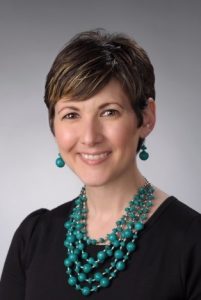
Dr. Karen Bull
Division of Online Learning
Before arriving at UNCG, Bull served as associate dean of academic affairs at Syracuse University. She also served as interim associate dean of academic affairs and online programs and manager of online programs and services at Syracuse University.
Her research has focused on undergraduate student characteristics that predict student persistence and performance in both online and face-to-face courses. She has presented at conferences on topics such as academic quality, assessment, and accreditation; distance education state authorization; and infusing learner-centered teaching into the online environment.
Active in professional and community organizations, Bull serves on the advisory board for the National Council for Online Education and as past chair of the mid-Atlantic region of the University Professional and Continuing Education Association.
As a lover of science fiction, I find myself picking movie genres that depict a future society fighting against the tyranny of unfair rulers protecting what they think is a utopian society. Ultimately, the masses win and freedom reigns. What our future society will look like depends on many things. Whether it will be dystopia of Ready Player One with residents escaping to a cyber-world for happiness or to a multi-class and segregated society where each class lacks something significant that another class has of The Hunger Games, we will never know exactly what the true future has in store for society. What we do know is that technology and the values of society will push us into one of many directions, one where we can expect greater automation with significant impacts to higher education. As we experience new technologies and new ways of doing things, the human element cannot be fully replaced. Leadership and creativity will need to be nurtured and developed through experience and education. The liberal arts degree is not a dead degree in our future. It just will look dramatically different.
Read more about why smart cities need liberal arts graduates.
The landscape of online higher education is changing with the growth of mega-universities and the advent of scores of MOOC-sized at-scale degree programs from prestigious universities.
Mid and small sized regional universities are seeing the some of the largest declines in enrollments. In assessing the cause of this disproportionate decline I believe, not enough consideration is being given to the impact of the growing trend of low-cost degrees offered at scale by top, prestigious universities. Starting just five years ago in 2015 with the Georgia Tech Online Master’s of Science in Computer Science (OMSCS), the field now has nearly 50 entries as of January of this year. And, many more are under development. The University of Pennsylvania is launching a baccalaureate in Applied Arts and Sciences. The formerly exclusive, 2U initiative has announced plans for their 3-year online baccalaureate in collaboration with the University of London. It is priced at $24,000. https://iblnews.org/2us-new-24k-online-undergrad-degree-trend-of-publicity-stunt/
Dwahl Shaw, founder of Class-Central, a site that follows closely the MOOC-based marketplace, says “the big change in 2018 was MOOC-based degrees. We ended 2017, with seven universities announcing 15 degrees, and in 2018 30 more universities joined in, and launched more than 45 degrees. I think we’ll see more of this in this 2019 too.”
At the same time, the so-called mega universities continue to grow. SNHU is bumping up against 100,000 online students. Western Governor’s University, a pioneer in competency-based education, now claims more than 110,000 students, mostly online. Arizona State University enrolls nearly half of its 72,000 students in online programs. With a high percentage of their 90,000 students online, UMUC enrollments are again on the upswing. Meantime, the University of Phoenix, Grand Canyon University, Liberty University and American Public University continue to serve very large online populations numbering in the many tens of thousands in each case.
Added together, the rapidly growing MOOC-based degree programs with the more traditional class-sized mega-universities, we may soon see more than a million students served efficiently and economically through these modes in the near term. Lee Gardner posits the business-forward thinking of these market driven institutions:
While some so-called mega-universities have physical campuses, they’ve focused intensely on building online programs. They’ve emphasized recruiting working adults over fresh high-school graduates. They’ve embraced competency-based education, in which students earn credits from life experiences and from demonstrating proficiency in a subject. They market widely and vigorously, and lean into, rather than recoil from, some other common corporate practices and philosophies. These universities have clearly found a new way to play the game that many colleges are losing.
At the same time we see these growth areas, overall college enrollment continues to decline for the eighth straight year. Combining the overall college enrollment decline with the growth of mega-universities and “at-scale” low cost, but high prestige, degree offerings, a vision of the future is coming into focus. There are fewer and fewer students to be served by the small and medium-sized regional universities. That accelerates the death cycle of rising tuition, fewer students, lower revenues, and, ultimately, more closures and mergers. This recently prompted Harvard’s Michael B. Horn to predict that 25% of the colleges and universities in the US will close or merge in the next twenty years.
So, what is to be done for the mid and small sized universities to survive in this environment? In the near term, it appears that “at scale” programs will be launched in popular, broad degree areas; the same for most mega-universities. That leaves more highly specialized, emerging market, just-in-time degree and certificate programs that meet the needs for newly forged career paths. Such programs will find an audience that is not yet large enough for the bigger institutions to consider offering at scale.
In order to take on these emerging online program areas, the small and medium sized institutions must be in close touch with business and industry. They must anticipate the emergence and growth in new fields. They must be nimble and decisive to move ahead with these new programs. Rather than competing head-to-head with Computer Science, MBA, Communication and other broad, traditional degree programs, they will be better served by specializing in sub-fields that are just now emerging. Leadership in these areas may have only a five or six-year life-cycle, but through continuous development of new programs, the smaller institutions will best attract new students and ultimately, the institutional bottom line.
There are important questions to raise on your campus, whatever the size. How will we compete in the changing landscape of the future of higher education? Are we identifying the emerging needs in society? What are our strength areas in which we might best launch new initiatives? Where do we fit in that emerging landscape? Are we prepared to support innovation and leadership in new fields? And, who will lead?
This article originally appeared in Inside Higher Ed’s Inside Digital Learning blog.
